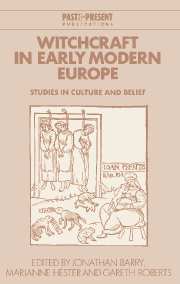Book contents
- Frontmatter
- Contents
- Preface
- Contributors
- 1 Introduction: Keith Thomas and the problem of witchcraft
- PART 1 THE CRIME AND ITS HISTORY
- 2 ‘Many reasons why’: witchcraft and the problem of multiple explanation
- 3 Witchcraft studies in Austria, Germany and Switzerland
- 4 State-building and witch hunting in early modern Europe
- PART 2 WITCHCRAFT AND RELIGION
- PART 3 THE MAKING OF A WITCH
- PART 4 WITCHCRAFT AND THE SOCIAL ENVIRONMENT
- PART 5 DECLINE
- Index
- Past and Present Publications
4 - State-building and witch hunting in early modern Europe
Published online by Cambridge University Press: 06 July 2010
- Frontmatter
- Contents
- Preface
- Contributors
- 1 Introduction: Keith Thomas and the problem of witchcraft
- PART 1 THE CRIME AND ITS HISTORY
- 2 ‘Many reasons why’: witchcraft and the problem of multiple explanation
- 3 Witchcraft studies in Austria, Germany and Switzerland
- 4 State-building and witch hunting in early modern Europe
- PART 2 WITCHCRAFT AND RELIGION
- PART 3 THE MAKING OF A WITCH
- PART 4 WITCHCRAFT AND THE SOCIAL ENVIRONMENT
- PART 5 DECLINE
- Index
- Past and Present Publications
Summary
During the last two decades a number of historians have attempted to establish a causal relationship between the great European witch hunt of the sixteenth and seventeenth centuries and the development of the modern state. These scholars have claimed that ‘the rise of the nationstate’ is at the very least one of the secondary causes of the witch hunt; that the hunt resulted from the centralisation of royal power; that it is one reflection of the advance of public authority against ‘particularism’ that it is integrally related to the assertion of reason of state; and that it proceeds from an impulse towards both absolutism and state sovereignty. The general impression one gets from this line of argument is that witches were in a certain sense victims of the advance of that emerging leviathan, the centralised, bureaucratised, secularised modern state. The purpose of this chapter is to examine this line of argument and to suggest some limitations to it. It will also test some of these theories about the connection between state-building and witch hunting with reference to one country in which it is alleged that they are especially apparent, the kingdom of Scotland.
The argument consists of four separate but related strands. The first deals with judicial and administrative centralisation, which is incontestably one of the most salient features of state development. Here the argument is that the growth of the state involved the advance of central, i.e. royal, jurisdiction, as a result of which areas which had enjoyed a large measure of autonomy, especially those on the geographical periphery of royal domains, came within the ambit of central government control.
- Type
- Chapter
- Information
- Witchcraft in Early Modern EuropeStudies in Culture and Belief, pp. 96 - 116Publisher: Cambridge University PressPrint publication year: 1996
- 9
- Cited by



